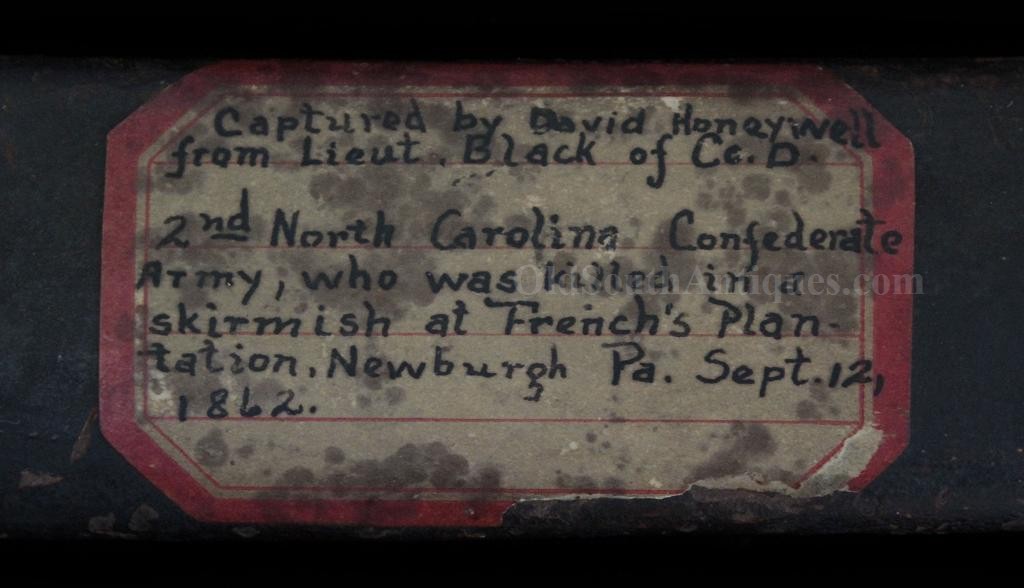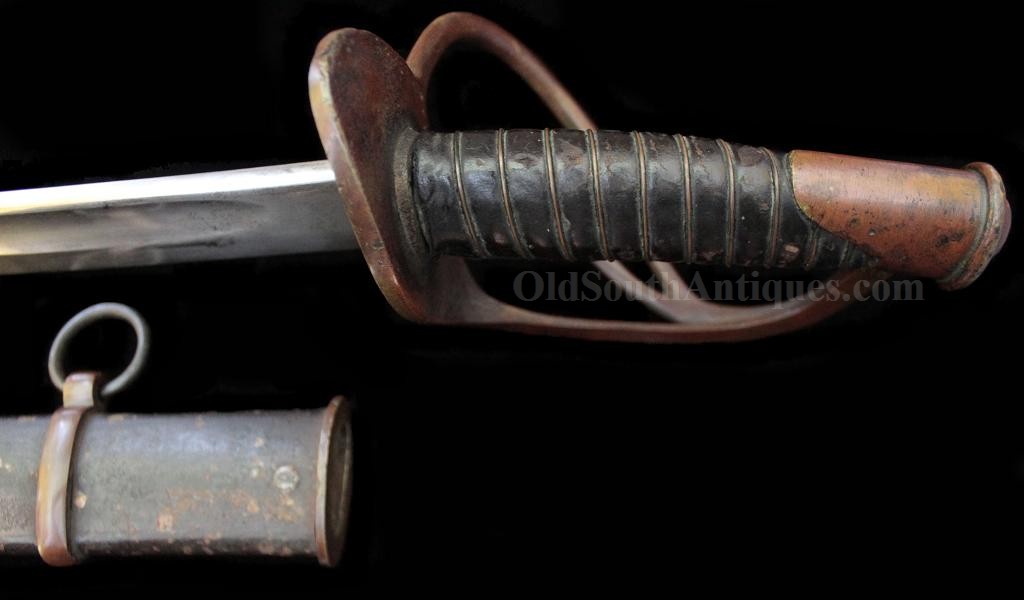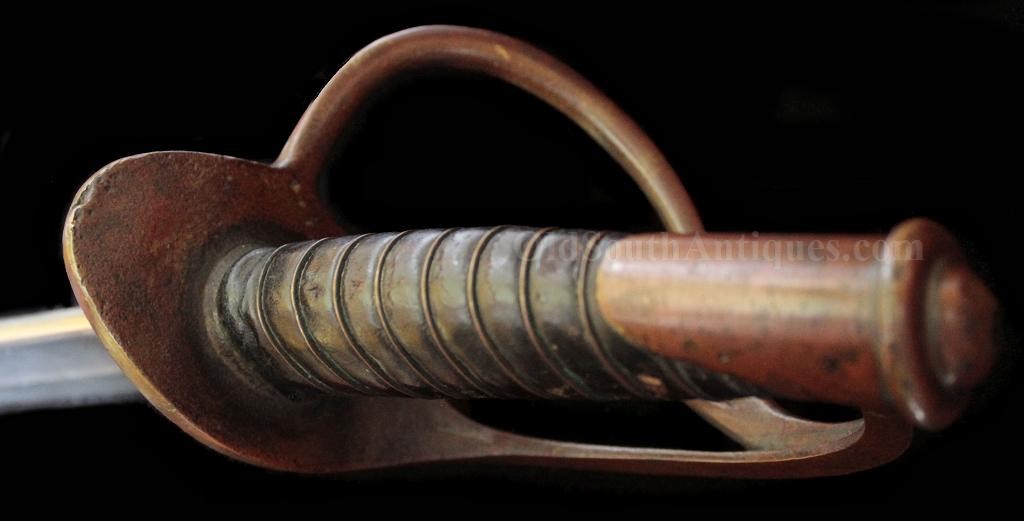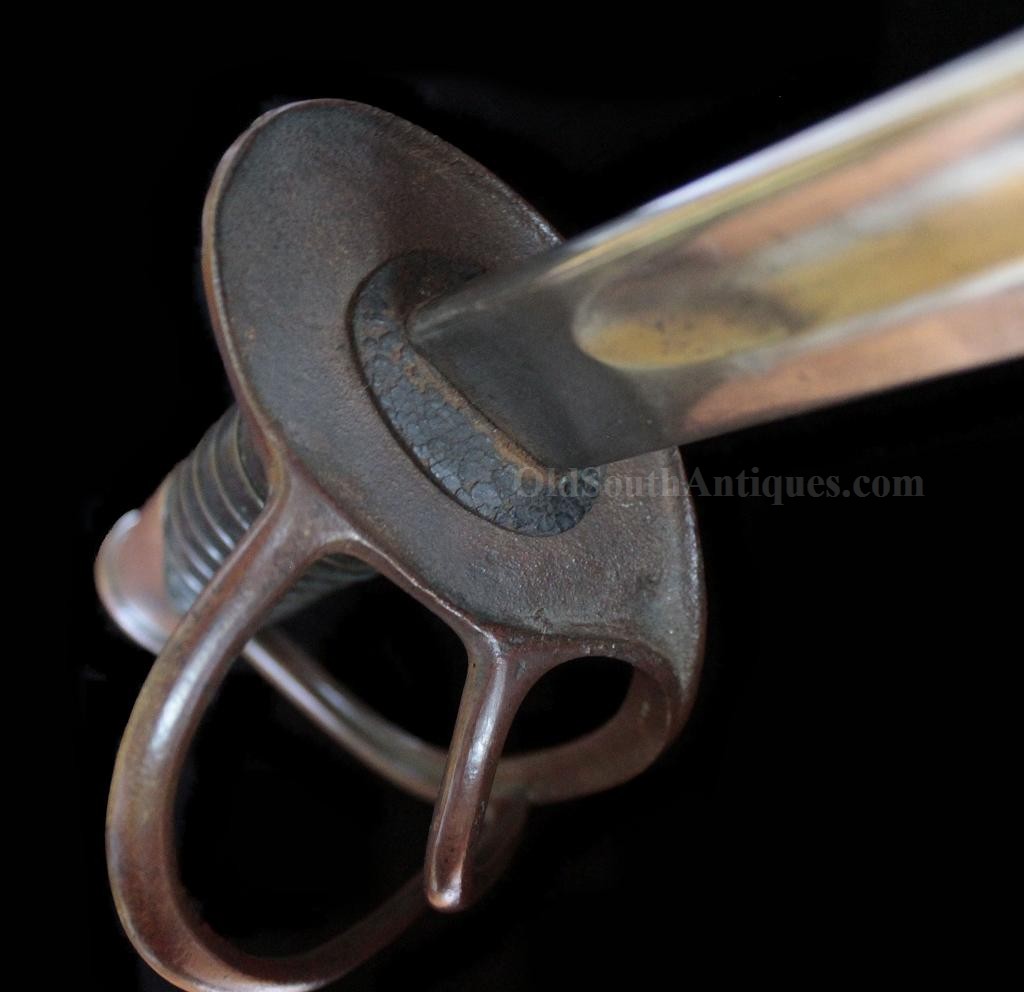
| Catalog | Past Items | Order Info | Terms/Conditions | About Us | Inventory Clearance |
The cavalry sword shown here is the classic Confederate Cavalry sword. There has long been a controversy as to the maker of this sword. Some say Kenansville because it is usually found in the same scabbard as the Kenansville cavalry sword. However, nothing else about the sword resembles a Kenansville in any manner. It has also been suggested that this is a product of Boyle and Gamble because of the similarity of the grip and the pommel to the Boyle and Gamble cavalry officer’s sabre, though the basket is totally different.
I own two of this pattern and have seen many more in an early Boyle and Gamble scabbard that were unquestionably original to the swords. This presents several possibilities, one, that someone was making scabbards and selling them to both Boyle and Gamble and Kenansville. This is very likely as it required different skills to make a scabbard than those needed to make a sword and it is known that Boyle and Gamble out sourced their officer’s sword scabbards to the Bosher Carriage Company. There are also several other sword makers, most notably, William McElroy and E.J. Johnston who shared common foundry men and other craftsmen. Also, there are several North Carolinaguns that share common component parts. In short, there can be no doubt that out sourcing was common throughout the Confederacy.
Another possibility is that this sword is a third Kenansville pattern, but this seems unlikely because Kenansville already had two models similar to each other, both of which usually utilize Roman numeral bench numbers. Bench numbers are never found on the sword shown here. It is my personal firm belief that this is a Boyle & Gamble’s enlisted man’s cavalry sword.
This sword was carried by Corporal Grier R. Black, Company B, 2nd North Carolina Cavalry right up until he was killed while wielding it in battle.
Black enlisted as Corporal of Company B on June 18, 1861 at Statesville, North Carolina (Captain Andrew’s Company). Surprisingly even at this early date he enlisted "for the war”, when most enlisted for a year at most. He was present with his company continually until July 28, 1862, when he was killed on Monday, July 28, 1862 at "French’s”, 13 miles from Newberne, NC.
Corporal Black’s sword has an important label affixed to its scabbard which reads:
"Captured by David Honeywell from Lieut. Black of Co. D, 2ndNorth Carolina Confederate Army, who was killed in a skirmish at Frenchs Plan-tation, Newburgh Pa Sept 12, 1862”.
There are several mistakes in this label. Black as a Corporal, not a Lieutenant, he was in Company B, not Company D, and it should have read Newberne, NC July 28, 1862, instead of Newburg Pa Sept 12, 1862. It is quite clear how this misinformation came to pass. The label is old, but there was once an older label or tag with the sword, and it had so faded that whoever put this label on, could not read it properly. However, the recorded events related to "Lieut. Black” and David Honeywell, leave no doubt as to its real history.
The 2ndCavalry had been picketing in the vicinity of Newberne throughout the spring of 1862 and had fought several engagements. At the time the regiment was poorly equipped. The North Carolina legislature had sent a request to North Carolina’s Governor, that he send an envoy to determine the "deficiencies of said regiment in horses, arms and equipments” in February. As a result, on March 11, 1862, North Carolina Governor Henry Clark wrote Confederate Secretary of War that "We tried in vain to get swords or carbines. This regiment was received by you but partly armed (from necessity). They are without sabers, although we spared neither effort nor money. We did engage from the Eastvan & Froelich sword factory at Wilmington, and paid high prices, but three fourths of the swords proved worthless.” …. "If you can let them have sabers they will be useful.” The appeal had the desired result; the regiment was issued at least Boyle and Gamble enlisted cavalry swords, as witnessed by the new condition of Corporal Black’s saber.
The Official Recordhas the July & August muster roll for Company B, 2nd North Carolina Cavalry, which gives an account of Corporal Black’s death: "On the 28 July, 1862, a portion of the company thirty in number was engaged in a skirmish with a combined force or cavalry & infantry of the enemy in which one sergeant, one corporal & eight men with twenty horses were taken prisoners. Corporal R G Black died a few hours afterwards of wounds received in the action”
Amazingly the Official Record also contains a Yankee account of the engagement written by Charles D. Sanford, 27th Massachusetts: "Ascertaining from the residents that French’s, a notorious rebel nest, was only a mile and a half farther on, I immediately moved forward and came on the house very suddenly, it being almost entirely concealed by trees. Sending Company D to the right and the cavalry forward, we nearly surrounded the house. We expected to meet the entire rebel force in that section there, and I therefore ordered charge and a fire while charging, considering it the shortest manner of ending the affair. The whole was well executed and promptly by the men. They fired a volley through the windows and yard, the volley being the first intimation the rebels had of our presence. They ran quickly, but only 4 escaped, 1 of them being wounded in the leg. The prisoners were brought in from the swamp and placed under guard and the house searched. Nothing was found of any value but a few sabers, the rifles and pistols being mostly worthless and condemned. Some 20 good horses were captured, only 4 escaping. The wounded of the enemy were placed in a wagon and sent under charge of the cavalry to the railroad. … we took 10 prisoners, 1 dead man being unintentionally left behind unburied, and 1 dying (Corp. Grier Black, of Mecklenburg County, North Carolina) on the return home…The prisoners…had been at French’s some three weeks”.
After his death, the 21-year-old Corporal Black was released, and his body interred in Iredell County’s Coddle Creek Church Cemetery. David Honeywell sent his captured sword back to his home in New York. Honeywell survived the War and afterwards he displayed it in the Union Veterans Union Hall, Washington, D.C., where he served as an officer.
The sword’s brass guard has a leather covered grip, and is wound with a copper wire wrap, both of which are virtually perfect. The grip and guard remain as tight as they were when new. The blade is in virtually new condition. The scabbard is crudely lapped and has a brass throat and ring mounts. The rings and drag are iron. The scabbard is also in nearly new condition, with the exception of a few paint chips, the original paint is intact. The sword and scabbard’s condition are phenomenal and it is a sight to behold; it is in virtually new condition. In more than 30 years of collecting and dealing in Confederate artifacts, this is the very best example of this pattern that I have ever encountered, and it has a wonderful history!
The best of the best, and only $9,900.00
Copyright © 2025 OldSouthAntiques.com All Rights Reserved.
Privacy Policy | Terms of Use
Powered by Web-Cat Copyright © 1996-2025 GrayCat Systems






